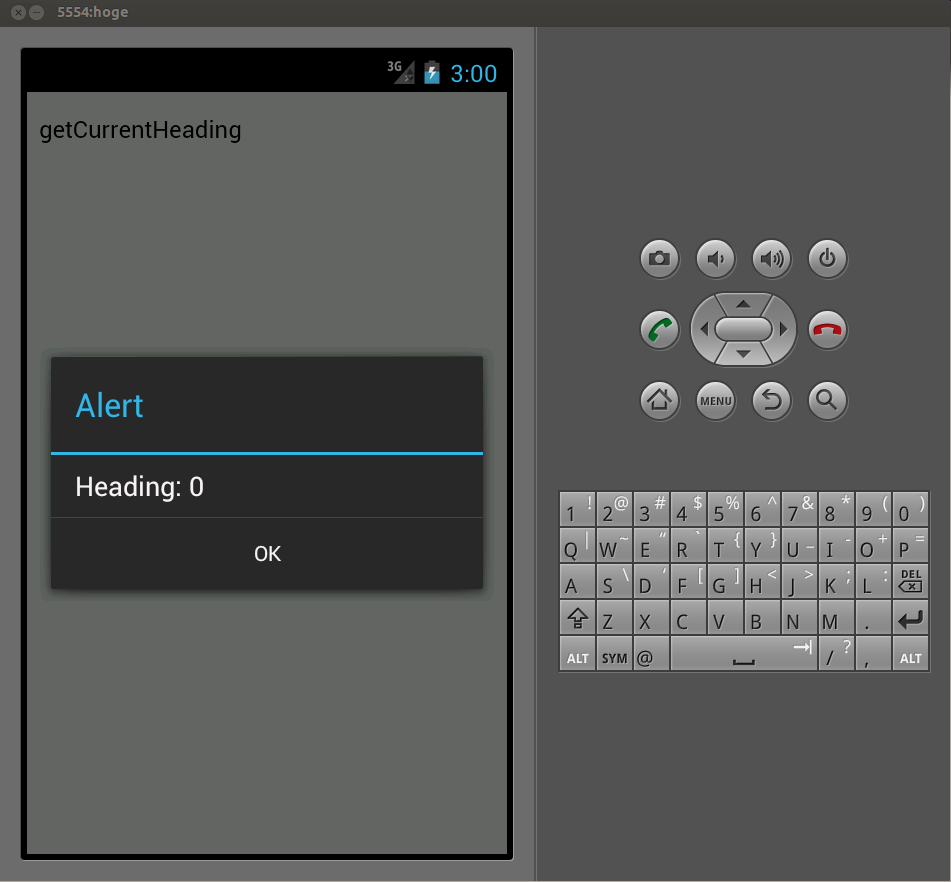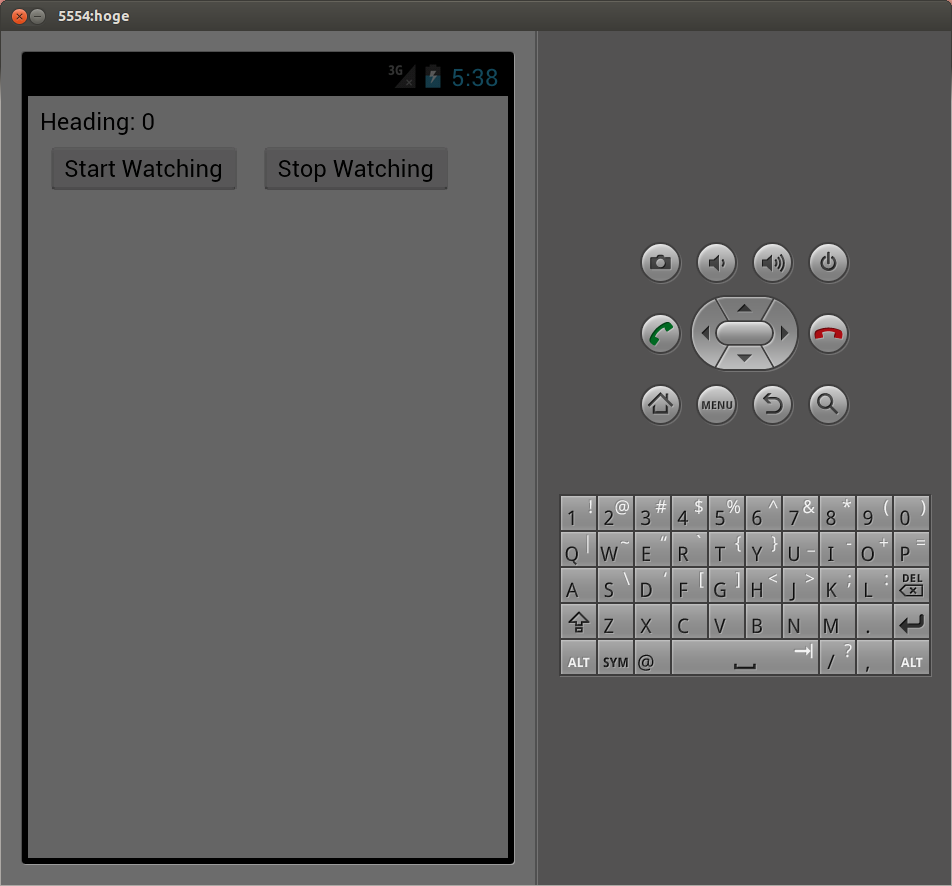PhoneGap を使って、簡単な Android アプリケーションを動かしてみる
【関連する外部ページ】:
前準備
JavaScript を使う HTML ファイルの例
- compass.getCurrentHeading: コンパスの向きの取得.向きは 9 から 359.99 までの角度で得られる
<?xml version="1.0" encoding="Shift_JIS"?> <!DOCTYPE html PUBLIC "-//W3C//DTD XHTML 1.0 Transitional//EN" "http://www.w3.org/TR/xhtml1/DTD/xhtml1-transitional.dtd"> <html xmlns="http://www.w3.org/1999/xhtml" xml:lang="ja" lang="ja"> <head> <meta http-equiv="Content-Type" content="text/html; initial-scale=1.0; charset=utf-8" /> <meta http-equiv="Content-Style-Type" content="text/css" /> <meta http-equiv="Content-Script-Type" content="text/javascript" /> <meta http-equiv="MSThemeCompatible" CONTENT="yes" /> <title> Compass Example </title> <script type="text/javascript" charset="utf-8" src="cordova-1.7.0.js"></script> <script type="text/javascript" charset="utf-8"> document.addEventListener("deviceready", onDeviceReady, false); function onDeviceReady() { navigator.compass.getCurrentHeading(onSuccess, onError); } function onSuccess(heading) { alert('Heading: ' + heading.magneticHeading); } function onError(compassError) { alert('Compass Error: ' + compassError.code); } </script> </head> <body> <p>getCurrentHeading</p> </body> </html>◆ 実行結果の例

- compass.watchHeading: コンパスの向きの取得.向きは 9 から 359.99 までの角度で得られる. 定期的に取得を行う関数で、その時間間隔を設定できる。
<?xml version="1.0" encoding="Shift_JIS"?>
<!DOCTYPE html PUBLIC "-//W3C//DTD XHTML 1.0 Transitional//EN" "http://www.w3.org/TR/xhtml1/DTD/xhtml1-transitional.dtd">
<html xmlns="http://www.w3.org/1999/xhtml" xml:lang="ja" lang="ja">
<head>
<meta http-equiv="Content-Type" content="text/html; initial-scale=1.0; charset=utf-8" />
<meta http-equiv="Content-Style-Type" content="text/css" />
<meta http-equiv="Content-Script-Type" content="text/javascript" />
<meta http-equiv="MSThemeCompatible" CONTENT="yes" />
<title>
Compass Example
</title>
<script type="text/javascript" charset="utf-8" src="cordova-1.7.0.js"></script>
<script type="text/javascript" charset="utf-8">
function startWatch() {
// 500 mili second
var options = { frequency: 500 };
watchID = navigator.compass.watchHeading(onSuccess, onError, options);
}
function stopWatch() {
if (watchID) {
navigator.compass.clearWatch(watchID);
watchID = null;
}
}
function onSuccess(heading) {
var element = document.getElementById('heading');
element.innerHTML = 'Heading: ' + heading.magneticHeading;
}
function onError(compassError) {
alert('Compass error: ' + compassError.code);
}
</script>
</head>
<body>
<div id="heading">Waiting for heading...</div>
<button onclick="startWatch();">Start Watching</button>
<button onclick="stopWatch();">Stop Watching</button>
</body>
</html>
◆ 実行結果の例

Geolocation
<?xml version="1.0" encoding="Shift_JIS"?> <!DOCTYPE html PUBLIC "-//W3C//DTD XHTML 1.0 Transitional//EN" "http://www.w3.org/TR/xhtml1/DTD/xhtml1-transitional.dtd"> <html xmlns="http://www.w3.org/1999/xhtml" xml:lang="ja" lang="ja"> <head> <meta http-equiv="Content-Type" content="text/html; initial-scale=1.0; charset=utf-8" /> <meta http-equiv="Content-Style-Type" content="text/css" /> <meta http-equiv="Content-Script-Type" content="text/javascript" /> <meta http-equiv="MSThemeCompatible" CONTENT="yes" /> <title> Geolocation Example </title> <script type="text/javascript" charset="utf-8" src="cordova-1.7.0.js"></script> <script type="text/javascript" charset="utf-8"> document.addEventListener("deviceready", onDeviceReady, false); function onDeviceReady() { navigator.geolocation.getCurrentPosition(onSuccess, onError); } function onSuccess(position) { var element = document.getElementById('geolocation'); element.innerHTML = 'Latitude: ' + position.coords.latitude + '<br />' + 'Longitude: ' + position.coords.longitude + '<br />' + 'Altitude: ' + position.coords.altitude + '<br />' + 'Accuracy: ' + position.coords.accuracy + '<br />' + 'Altitude Accuracy: ' + position.coords.altitudeAccuracy + '<br />' + 'Heading: ' + position.coords.heading + '<br />' + 'Speed: ' + position.coords.speed + '<br />' + 'Timestamp: ' + new Date(position.timestamp) + '<br />'; } function onError(error) { alert('code: ' + error.code + '\n' + 'message: ' + error.message + '\n'); } </script> </head> <body> <div id="geolocation">Waiting for geolocation ...</div> </body> </html><?xml version="1.0" encoding="Shift_JIS"?> <!DOCTYPE html PUBLIC "-//W3C//DTD XHTML 1.0 Transitional//EN" "http://www.w3.org/TR/xhtml1/DTD/xhtml1-transitional.dtd"> <html xmlns="http://www.w3.org/1999/xhtml" xml:lang="ja" lang="ja"> <head> <meta http-equiv="Content-Type" content="text/html; initial-scale=1.0; charset=utf-8" /> <meta http-equiv="Content-Style-Type" content="text/css" /> <meta http-equiv="Content-Script-Type" content="text/javascript" /> <meta http-equiv="MSThemeCompatible" CONTENT="yes" /> <title> Geolocation Example </title> <script type="text/javascript" charset="utf-8" src="cordova-1.7.0.js"></script> <script type="text/javascript" charset="utf-8"> document.addEventListener("deviceready", onDeviceReady, false); var watchID = null; function onDeviceReady() { // Update every 2 seconds var options = { frequency: 2000 }; watchID = navigator.geolocation.watchPosition(onSuccess, onError, options); } function onSuccess(position) { var element = document.getElementById('geolocation'); element.innerHTML = 'Latitude: ' + position.coords.latitude + '<br />' + 'Longitude: ' + position.coords.longitude + '<br />' + '<hr />' + element.innerHTML; } function onError(error) { alert('code: ' + error.code + '\n' + 'message: ' + error.message + '\n'); } </script> </head> <body> <div id="geolocation">Waiting for geolocation ...</div> </body> </html>
![[kaneko lab.]](https://www.kkaneko.jp/info/logo_png.png)